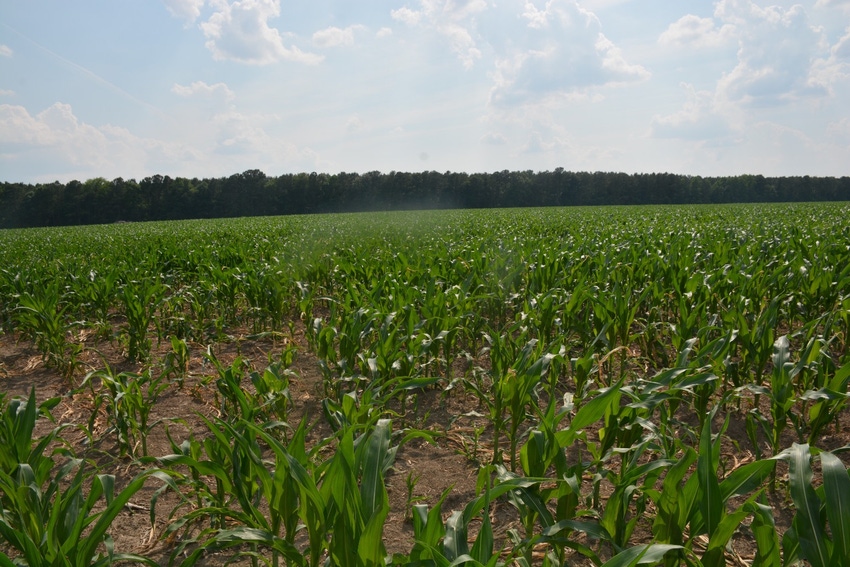
Fertilizer prices are expected to remain high in 2022. Farmers will be doing all they can to make sure they don’t apply more fertilizer than needed to make yield.
This summer, the Agronomic Division of the North Carolina Department of Agriculture and Consumer Services lowered its official phosphorus recommendations for corn, wheat and soybeans across North Carolina for the upcoming growing season.
David Hardy, chief of soil testing for NCDA, says this change was not related to increases in fertilizer prices, but was due to careful review of prior research that was never implemented by the division. “The change just so happens to coincide with rising prices. Potassium recommendations remain the same,” he notes.
When it comes to nitrogen, Deanna Osmond, professor, and Crop & Soil Sciences Department Extension leader at North Carolina State University, is reminding farmers they can often reduce nitrogen applications in corn without impacting yield.
“They are doing a good job of applying nitrogen, but recent trials show many corn farmers can cut back nitrogen by 25% and not affect yields,” Osmond emphasizes. “The trial also showed the nitrogen recommendations by county, soil type, and crop provided by North Carolina State University are reliable.”
Less phosphorous
On phosphorous, Hardy, says the big take away message is that North Carolina corn farmers are unlikely to see lower yields by applying less phosphorous to corn. Hardy notes that most soil tests conducted by his lab have shown soil samples across North Carolina to be high or very high in phosphorous.
“In terms of phosphorus index (P-I) soil test levels using Mehlich 3 soil test extractant, high is 50 to 100 and very high is greater than 100. Historical research reveals that lower rates of phosphorus are warranted in grain crops across North Carolina,” Hardy says.
“Our lab has been very liberal in recommending phosphorous for many decades. Our rates are among the highest of any state in the Southeastern United States. There is a large variation in phosphorous rates recommended among public labs. Today, there is an ongoing effort among about 80 universities to come to a consensus on fertilization recommendations and their development,” he adds.
Hardy says a project called FRST, the Fertilization Recommendation Support Tool, is well underway in this effort. The goal is to establish more uniform fertility recommendations across the Southeast. Osmond is a leader in the effort.
Osmond notes that North Carolina nearly always has had the most generous phosphorous recommendations of the Southern states. In essence, she says North Carolina corn farmers over the years were applying more phosphorous than the crop needed.
Osmond explains that the data goes back 30 years, and the recommendations clearly needed to be updated. “We realized the recommendations were more than generous and should be cut back. We moved the needle back. You can apply less phosphorous.”
It turns out that North Carolina farmers have done a good job of phosphating their soils over the years. Osmond says research clearly shows that in most years, farmers don’t see a yield advantage even when applying starter phosphorous due to the already high level of phosphorus in most North Carolina soils.
“Most farmers will actually see no change in their yield by just leaving the phosphorous out,” Osmond said.
The research, conducted by Osmond, in cooperation with Luke Gatiboni, North Carolina State Extension soil fertility specialist, looked at applying starter phosphorous and starter nitrogen. “Starter phosphorous didn’t make any difference. Starter nitrogen makes a difference, but not phosphorous,” Osmond says.
Phosphorous savings account
When it comes to phosphorous, Osmond encourages farmers to think of a savings account. Phosphorous built into the soil over the years is like a savings account and now is the time for farmers to tap into that savings account and not apply phosphorous if the crop doesn’t need it.
“The whole point of a savings account is that when things get rough, you start drawing into it. Data shows a Mehlich-3 P-I of 150 for phosphorus is easily three times more than a farmer needs to grow a crop. You could probably get away with not putting on any phosphorous for 30 years and still not affect your yields,” she says.
As for the FRST project, Osmond says it is time for fertilizer recommendations to be more uniform across the Southeast. The goal of FRST is to make that happen. She says fertility recommendations won’t be identical for each state, but they will be better aligned.
“There is no reason North Carolina should be different than South Carolina or South Carolina should be different than Georgia. Recommendations won’t be identical, but will be a little closer than they are now,” she says.
In the meantime, Gatiboni says farmers continue to raise concerns about high fertilizer prices. He says dealing with these high fertilizer prices will be one of the most important management decisions for corn farmers in 2022. He says soil tests are critical and for farmers to apply fertilizer in a timely way and only when needed.
More cotton, soybeans. Less corn
Hardy and Gatiboni expect more cotton and soybeans will be grown in North Carolina at the expense of corn next year due to better prices for those crops and less need for expensive nitrogen fertilizer.
“Corn is the crop most affected by higher nitrogen prices,” Gatiboni says.
Gatiboni says an important lesson from 2009, when phosphorus fertilizer prices were sky high and farmers reduced applications, is that yields across the country did not decline due to less fertilizer being used.
“Because of high fertilizer prices, next year will be a very good time to start using the savings account,” Gatiboni says, confirming Osmond’s comments.
As for potassium, Hardy says NCDA’s Agronomic Division is not recommending reduced applications next year, but farmers can manage timing of applications as one way to cut costs.
“We have a lot of growers with large acreage, and they have to get across that large acreage. Not spreading potassium, which is leachable, too early is key. Our recommendations seem to be pretty solid from the K standpoint,” Hardy said. “Research over a three-year period (2016-2018) validated that our K recommendations work well.”
Gatiboni also urges corn farmers not to cut back on potassium if their soil sample calls for it.
“We had a lot of rain this last season. It would probably be a good time for farmers, especially in the Coastal Plain, to sample their soil and do an analysis because they may have had some leaching. They may need to replenish some potassium,” he advises.
About the Author(s)
You May Also Like






